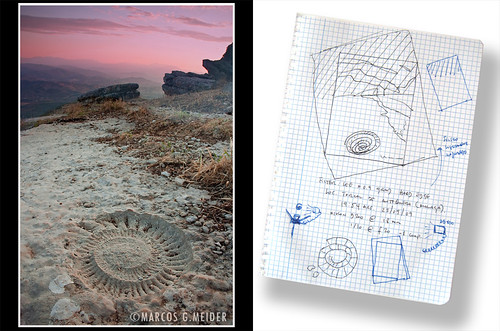As it was dusk, the dynamic range between the ground and the sky was too steep for the camera's sensor to exposed correctly. The ground was in shade and the sky had "to much" luminosity. The only way to successfully get the image was to grab a ND filter 0.9 (3 stops). The hillside had a slight inclination so it was obvious that I had to tilt the filter at approximately the same angle to compensate the exposure and try to equalise it. If I didn't want to end up with a neck ache I had to use a right angle view and a cable release shutter to avoid any camera shake. I took several pictures and I think this is the best of the series.
See you in the next post!
Nikon D200 · 18mm · SB800 Nikon @ 1/8 · NG Lee 0.9 Hard Edge · tripod · cable ·
Exp.: 1/10 @ f20 (-1 comp) ISO 100
Exp.: 1/10 @ f20 (-1 comp) ISO 100
Antiguamente el Parque Natural del Torcal de Antequera estaba cubierto por el antiguo mar de Tetys y en sus aguas vivían numerosas especies animales como este Ammonites. La retirada de las aguas dejó al descubierto a numerosos individuos en forma de fósiles. En este caso tenía la imagen en la cabeza. Al caer la tarde y con un cielo apropiado quedaría una imagen interesante, a mi parecer. Para ello situé el trípode a la menor altura posible, unos 11 cm del suelo, para poder encuadrar con el gran angular y a mi derecha situé un flash Nikon SB800 a 1/8 de potencia para darle relieve al ammonites.
Al estar cayendo la tarde, el rango dinámico entre el suelo y el cielo era demasiado amplio con lo que el sensor de la cámara no iba a poder registrar de manera correcta todo el escenario. El suelo estaba en sombra y el cielo tenía "demasiada" luminosidad. La única alternativa era echar mano de un filtro degradado neutro 0.9 (3 puntos). Como la ladera tenía una inclinación, lo lógico era inclinar el filtro aproximadamente en la misma dirección para compesar la diferencia de exposición e intentar igualarlo. Con la ayuda de un visor de ángulo recto para no acabar con dolores en el cuello y un cable disparador para evitar en lo posible la trepidación de la cámara, realicé unas cuantas fotos siendo esta la mejor de la serie.
¡Os veo en el siguiente post!


No comments:
Post a Comment